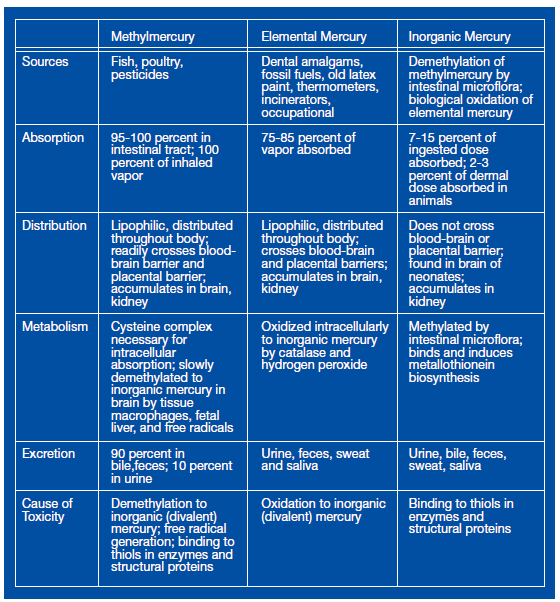Mercury is a naturally occurring heavy metal, found throughout the environment, with many harmful health effects.
What is mercury?
Mercury is a naturally occurring heavy metal found throughout the environment (soil, fossil fuels, minerals). We can absorb mercury via inhalation, through our skin and when we eat.
Mercury exists in 3 forms:
- elemental (e.g., in thermometers, tooth fillings)
- inorganic (e.g., batteries, disinfectants)
- organic (e.g., methylmercury in fish, pesticides, fungicides, insecticides, some vaccines)

Mercury’s not essential in our diet. In fact, it’s definitely not good for us.
Where we get mercury
Mercury can be introduced into the food supply in a variety of ways, most commonly as a byproduct of pollution. Burning fossil fuels and mining (mercury is used to extract gold) emit inorganic mercury vapor into the atmosphere. This mercury floats around and eventually settles into waterways, where it’s organified to methylmercury by microorganisms.

Mercury exposure is the second most common toxic metal poisoning in North America. The greatest risk comes from the mercury we consume in our diet (methylmercury).
The most common dietary source of toxic methylmercury is seafood. But it can also come from:
- Livestock who are fed contaminated fishmeal
- Plants grown in mercury-contaminated soil
- Foods stored in pottery with mercury-based paint
- Duck eggs
- Chemicals used on food crops (e.g., pesticides)
- Protein powder (see here)
- Fish oil (check with the company to make sure they test for toxins).
Mercury & seafood
Mercury accumulates in tissues, in both fish and humans. Larger and older fish have eaten more, so they accumulate more. Farmed fish tend to have lower methylmercury levels because they have a shorter life span and enhanced growth rates (thus, bioaccumulation is lessened).
If you eat fish, find out more about mercury levels here.
Methylmercury intake guidelines
- The FAO/WHO “provisional tolerable weekly intake” is 1.6 mcg/kg
- The U.S. EPA safe level for daily intake is 0.1 mcg/kg
- U.S. Pharmacopeia recommends less than 15 mcg/day.
Cooking/cleaning fish does not destroy methylmercury and most is stored in fish muscle rather than fish fat, so trimming fat doesn’t help.
High mercury intake during pregnancy results in irreversible problems for the fetus. Still, in some regions with limited sources of protein and omega-3 fats, fish can benefit the growing fetus.
The FDA has set limits on fish consumption during pregnancy (some experts think these recommendations are too relaxed). See here.
What happens when we consume mercury?
We absorb and disseminate methylmercury well when we eat it — it easily passes through the gastrointestinal wall and is distributed throughout the body within 30 hours. Mercury can affect nearly all organs and is able to cross the blood-brain and placental barriers (creating irreversible problems for a growing fetus).
Chronic mercury exposure causes serious health problems, especially for the nervous system and kidneys. Mercury might also harm cardiovascular health, DNA transcription, calcium balance, and protein synthesis. Mercury’s also been linked to multiple sclerosis and autism and may promote oxidative stress and inflammation.
Mercury toxicity has a wide range of symptoms, which reflect mercury’s widespread effects in the body. These include:
- Neurological: tremors, balance problems, numbness, acrodynia (painful extremities)
- Mood and psychological well being: shyness, emotional instability, personality changes, insomnia
- Cognition: memory loss insomnia
- Pain: headache and acrodynia (painful and discoloured extremities, especially in children)
- Oral health: gingivitis and loss of taste
- Hearing problems
Mercury toxicity has been referred to as the “invisible epidemic”, since the impact is not immediately noticed and builds over time.
Mercury can begin to leave the body in a few days or a few months. This varies greatly based on the organ of deposition and the form of mercury. While we can excrete mercury in urine, feces, sweat, saliva, breast milk and tears, the body isn’t very efficient at this. The half-life (time required for something to fall to half of its initial value) is about 45-70 days in the human body.
In other words, if we consume mercury faster than we can excrete it, it builds up.
Diagnosing mercury toxicity
Diagnosis of mercury overload is difficult given the wide variety of testing. Hair, nails and blood are biomarkers of mercury exposure. Blood measures aren’t entirely useful since they indicate only recent exposure. And with hair, there is a 1-2 month delay before mercury will even show up. Clinical toxicity from mercury is doubtful if blood and urine concentrations are less than 100 mcg/L.
DMSA (succimer), DMPS (unithiol), or penicillamine testing might be the most accurate way to identify mercury overload. Indeed, DMPS (unithiol) has been used in Germany for the past 50 years. These tests need to be done with a trained physician, since most everyone will test positive.
Can we detox from mercury?
“Mercury detox should be done very, very carefully with a trained practitioner.” – Dr. Bryan Walsh
We all love a good detox. Problem is, if we mobilize mercury from other tissues, it might just relocate to another organ and/or initiate an immune response, worsening toxicity. Not good. The body must be ready to handle any “detoxed” mercury.
With that being said, the nutrients we consume can interact with toxic metals at various points in the body, including absorption, excretion, transport, binding, metabolism and oxidation. In other words, the nutrient content of the diet can impact one’s potential for mercury toxicity. As you’ll see below, many vegetables and fruits in particular, along with non-contaminated omega-3s and mineral-rich protein sources, can support mercury detox.
Mercury and other nutrients
Zinc and selenium
Mercury can bind zinc and selenium, making them useless in the body and preventing them from doing their jobs. At the same time, this binding of mercury to zinc and selenium can render mercury less harmful to our cells. Remember, while selenium and zinc are essential nutrients for human health, they are also toxic in high amounts.
Vitamin E
When methylmercury is broken down in the body, free radicals are formed. Dietary Vitamin E can help fight them off and stabilize damaged cell membranes.
Pyruvate
Pyruvate and catalase can reduce methylmercury induced cell injury. Dietary sources of pyruvate include apples, beer, and wine — but you’d have to consume a lot of these to get the same dose as supplemental pyruvate. Many fruits and vegetables, as well as organ meats, are sources of catalase, although it occurs naturally in all living organisms.
Glutathione
Methylmercury neurotoxicity may be blocked by glutathione (glutathione peroxidase activity is decreased after exposure to mercury), catalase and cysteine. Glutathione can bind mercury and prevent it from damaging tissues, increase the antioxidant capacity of our cells, and bind mercury, which helps eliminate it from the body.
Supplementing with whey protein may help to rebuild glutathione levels and chelate heavy metals in the body (other protein supplements may help too–but make sure the protein supplement itself is free from heavy metals).
Cysteine, methionine & cruciferous vegetables
Eating more sulfur-rich foods (especially cruciferous vegetables and foods from the Allium genus, such as garlic, onions, and leeks) might help to prevent mercury buildup in the body, since mercury can bind sulfur-containing amino acids.
Foods high in cysteine can help make metallothionein, a heavy metal binding protein (supplementing NAC (N-Acetyl-Cysteine) might be useful here).
Methionine may reduce methylmercury induced liver damage and weight loss.
Alpha-lipoic acid
Alpha-lipoic acid may chelate heavy metals and help remove mercury from the body. It might also boost glutathione in our cells.
Omega-3 fats
Seafood can be a double-edged… ummm… swordfish. (Sorry.)
On one hand, beneficial omega-3 fats from fish and seafood might help to mitigate some of the health consequences of methylmercury intake (particularly cardiovascular health). On the other hand, of course, if dietary seafood is a prime source of methylmercury, then you lose the protective benefits.
Thus, choose marine food sources that are higher in omega-3s but lower in mercury, such as krill or algae oil, or smaller fish.
Protein
How much and what type of protein you eat may matter: A low protein intake may worsen mercury’s neurological effects.
Dark colored fruits and vegetables
Colorful fruits and vegetables contain chemicals known as flavonoids, which affect the biological balance of metals (including zinc and copper).
Summary and recommendations
Fight the power (usage)
We can avoid eating fish that accumulate mercury, and try not to bite our mercury thermometers, but this won’t get to the root cause of the problem. Mercury in the food chain comes from pollution from industrial production and fossil fuel burning (especially coal). In order to get mercury out of our bodies and food for good, we need to work on the fundamental issue of mercury in our ecosystems.
Wherever you can decrease your reliance on electricity and fossil fuels (especially coal), do it. For example, you can:
- carpool;
- take public transportation;
- bicycle;
- walk;
- turn off lights when you don’t need them;
- use less hot water;
- turn down your thermostat in winter;
- turn up your thermostat in summer (or don’t use air conditioning);
- take shorter showers;
- wash clothes with cold water; and/or
- spend less time on electronic devices
Eat the right foods, in the right amounts
Eat less. Think about it: Even if what you eat is lower in methylmercury, if you eat a lot of it, the toxins can still accumulate. If you overeat, this is one more reason to tackle that habit.
Eat less seafood and eat more mercury-free plant foods. Maybe instead of eating fish three times per week, eat it once and then eat more plant-based sources of omega-3’s (algae oils, chia, hemp, flax). This can lower reliance on fish. (Note: I contacted several algae oil supplement companies and they test for mercury.)
Eat different fish. Instead of big, predatory fish, eat smaller, non-predatory fish. If you catch local fish, check with local sources about potential mercury contamination. Over 3,000 lakes in the U.S. have been closed to fishing due to mercury contamination.
Consume enough nutrient-dense plant foods. These foods can help your body fight off mercury. The following foods are rich in some of the nutrients discussed above:
- Vegetables: cruciferous vegetables, avocado, asparagus, acorn squash
- Fruits: watermelon and strawberries
- Nuts: Brazil nuts, walnuts, and cashews; coconut
- Seeds: pumpkin, hemp, flax, and chia seeds
- Whole grains: oats
- Legumes: lentils
- Herbs and spices: garlic, turmeric
Remove mercury around you
Avoid mercury tooth fillings. Find a dentist with experience in removing and replacing old mercury fillings.
If you’re feeling technical, the Jerome meter is a handheld device that gives mercury readings for indoor air.
Check your protein powder, fish oil and/or algae oil. Call the company and ask about heavy metal testing.
Eat, move, and live… better.©
Yep, we know… the health and fitness world can sometimes be a confusing place. Even when it comes to something as simple as shoes. But it doesn’t have to be.
Let us help you make sense of it all with this free special report.
In it you’ll learn the best eating, exercise, and lifestyle strategies — unique and personal — for you.
Click here to download the special report, for free.
References
Click here to view the information sources referenced in this article.




Share